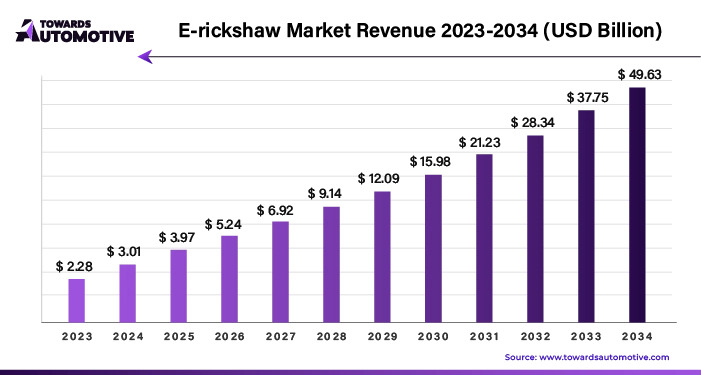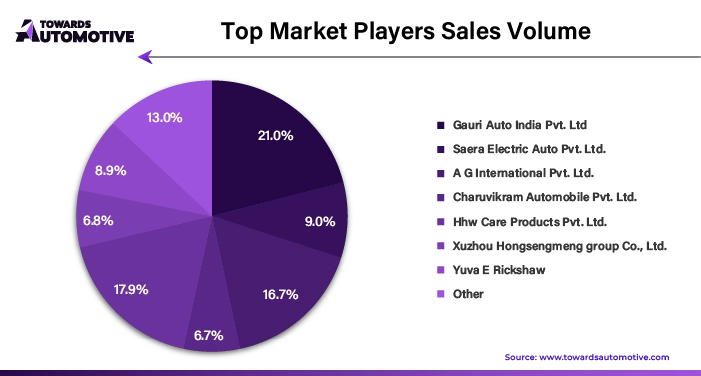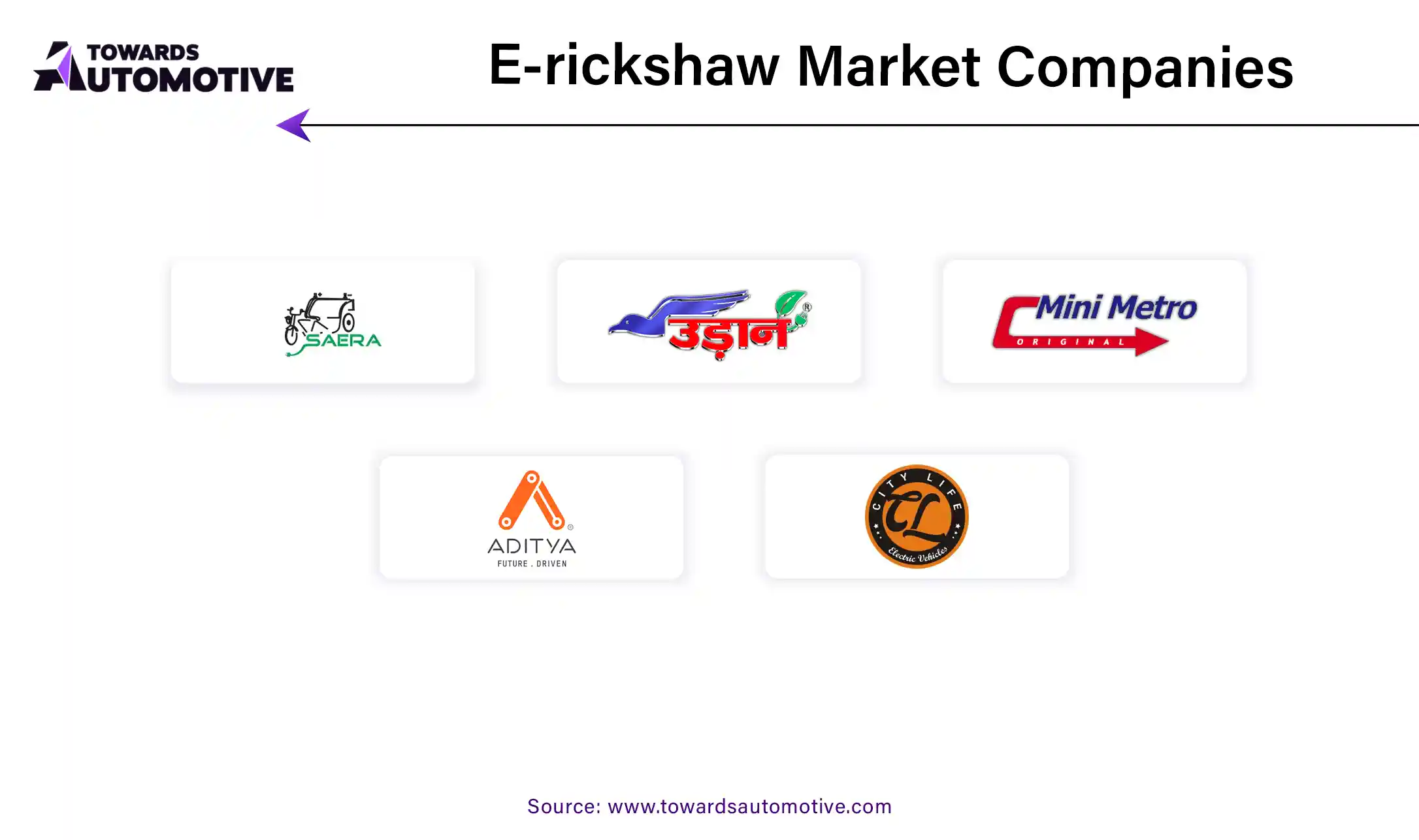March 2025
The global e-rickshaw market is predicted to expand from USD 3.97 billion in 2025 to USD 49.63 billion by 2034, growing at a CAGR of 32.02% during the forecast period from 2025 to 2034.

Unlock Infinite Advantages: Subscribe to Annual Membership
The e-rickshaw market is experiencing significant growth as automotive manufacturers venture into this sector with innovative models. This surge in activity is further fueled by infrastructure development projects led by governments worldwide, which are improving the accessibility and maintenance of e-three-wheelers.
Electric vehicle (EV) manufacturers are increasingly collaborating with public and government authorities to accelerate the adoption of electric rickshaws. These partnerships focus on expanding charging infrastructure and advocating for policies that support electric vehicle integration.
Smart city initiatives present a valuable opportunity for the electric rickshaw sector. These projects emphasize enhancing urban mobility solutions, creating an ideal environment for incorporating e-rickshaws into public transport networks.
Local production of lithium-ion battery-based electric auto-rickshaws is driving consumer interest. Manufacturers are introducing buyback schemes that offer discounts on new lithium-ion battery-based e-rickshaws when customers trade in their old lead-acid battery models for proper disposal.
Despite these advancements, the electric rickshaw sector faces significant challenges. The lack of standardization in quality, safety, and performance can lead to the proliferation of low-quality e-rickshaws. Additionally, key components needed for production are still being imported, posing logistical and cost challenges for manufacturers.
In response to these challenges, key players are focusing on developing cost-effective three-wheeled EVs with advanced technology. This strategy aims to provide consumers with a compelling mix of affordability and cutting-edge features, making it an attractive option in the rapidly evolving e-rickshaw market. The automotive market valued at USD 4,070.19 billion in 2023, is experiencing growth and is projected to surpass USD 6,678.28 billion by 2032, with a significant CAGR of over 5.66%.
Boosting Tourism with E-Rickshaws
E-rickshaws are becoming a popular choice for tourism due to their eco-friendly nature, characterized by zero tailpipe emissions. This makes them an excellent option in destinations that prioritize environmental preservation. Their compact size allows them to navigate narrow streets and alleyways, providing tourists with access to hidden gems and local neighborhoods that are off-limits to larger vehicles. E-rickshaws offer a cost-effective and flexible means of sightseeing. However, one limitation is their restricted range, which can affect longer trips.
E-Rickshaws Revolutionizing Last-Mile Connectivity
In developing countries and urban areas where traditional transport systems like buses and metros fall short, e-rickshaws are proving indispensable for last-mile connectivity. Their compact design allows them to reach areas that are otherwise inaccessible to conventional transport. This affordability and versatility make e-rickshaws a vital part of urban transport solutions. They cater effectively to local transportation needs, offering convenient door-to-door service and enhancing the mobility of residents.
For instance, in July 2024, Lohia Auto, electric automobiles manufacturers, headquartered in India, revealed the introduction of new electric three-wheeler (E3W) models. The Lohia Auto company revealed that there are over five new models pipelined for the Indian market.
Boosting E-Rickshaw Profitability Through Battery Swapping Technology
The advent of battery-swapping technology is transforming e-rickshaw operations. Traditionally, charging an e-rickshaw battery can take several hours, causing downtime. Battery-swapping allows drivers to exchange a depleted battery for a fully charged one within minutes, maximizing operational time and earnings. This technology not only extends the e-rickshaw's range but also enables drivers to undertake longer routes and complete more trips without extended interruptions.
Battery-swapping stations, which use standardized batteries, address compatibility issues and streamline battery maintenance and charging. This infrastructure reduces the need for drivers to invest in home charging stations and mitigates reliance on public charging points, ultimately lowering overall charging costs.
AI integration is set to revolutionize the electric auto-rickshaw market by significantly enhancing operational efficiency and customer experience. By incorporating advanced AI technologies, manufacturers can optimize route planning and improve energy management, leading to increased vehicle efficiency and reduced operational costs. AI-driven systems enable real-time data analysis, allowing for predictive maintenance and timely repairs, which minimizes downtime and enhances vehicle longevity.
Moreover, AI enhances safety features through advanced driver assistance systems (ADAS) that offer collision avoidance, lane-keeping assistance, and real-time traffic updates. These features not only improve safety but also boost consumer confidence and attract more buyers. Additionally, AI-powered customer service solutions, such as chatbots and personalized recommendations, offer a better user experience and streamline customer interactions.
AI integration also supports market expansion by enabling the development of smarter and more connected e-rickshaws. This advancement meets the growing demand for eco-friendly and efficient transportation options, driving market growth. As a result, AI is poised to play a crucial role in shaping the future of the electric auto-rickshaw market, fostering innovation and sustainability.
The supply chain in the e-rickshaw market operates through a series of interconnected stages, each vital for ensuring the efficient production and distribution of electric rickshaws. It begins with the procurement of raw materials such as batteries, electric motors, and chassis components from suppliers. These materials are then delivered to manufacturing units where they are assembled into finished e-rickshaws.
Manufacturers rely on a network of suppliers for quality components, and they coordinate with logistics providers to ensure timely delivery. Once assembled, e-rickshaws are distributed to dealers and showrooms through a well-organized distribution network. The final stage involves the delivery of the e-rickshaws to end-users, often through direct sales or rental services.
Effective supply chain management in the e-rickshaw market requires careful coordination among suppliers, manufacturers, distributors, and dealers. By maintaining robust communication and leveraging technology for inventory and logistics management, the industry can address challenges such as supply shortages and demand fluctuations. This streamlined approach ensures that e-rickshaws are readily available to meet growing consumer demand and contribute to the market's expansion.
The E-rickshaw market is driven by several critical components and the contributions of various companies. At its core, an E-rickshaw comprises the battery, electric motor, controller, and chassis. The battery, usually lithium-ion or lead-acid, provides the power necessary for operation, while the electric motor converts this power into movement. The controller regulates the flow of electricity, ensuring smooth acceleration and braking. The chassis supports the entire structure, ensuring durability and safety.
Companies play a vital role in this ecosystem by specializing in different components and services. Battery manufacturers like Exide and Amara Raja focus on developing high-efficiency, long-lasting batteries. Electric motor producers such as Bosch and Siemens provide advanced motors that enhance performance and reliability. Controller and electronic component suppliers, including companies like Texas Instruments and Infineon, offer sophisticated control systems that optimize the driving experience. Additionally, chassis and frame manufacturers contribute by designing robust and lightweight structures that enhance the E-rickshaw’s efficiency and safety. Each company's innovations and expertise collectively push the market forward, driving growth and technological advancement in the E-rickshaw sector.
India’s urbanization has been a major driver of economic growth, with cities playing a crucial role in the country's economic output. As urban areas continue to expand, the need for sustainable and inclusive development becomes increasingly urgent. One key development in this area is the shift towards electric vehicles, particularly in the auto-rickshaw segment. This transition to electric mobility is an important step towards a more sustainable urban future.
The Evolution of Auto-Rickshaws
Auto-rickshaws have been a fundamental part of India’s urban transportation network since the late 1950s, offering crucial first- and last-mile connectivity. With a fleet of over 7 million vehicles, these three-wheelers serve a wide range of socio-economic groups. Technological advancements over the years have led to increased efficiency and reduced emissions, including a shift to compressed natural gas (CNG) operations. Today, the focus is on electrifying auto-rickshaws, marking a significant move towards sustainable urban transport.
A Growing Trend
Recent data highlights the rise of e-rickshaws in India. According to Vahan data from 2023, Uttar Pradesh leads with 403,411 registered e-rickshaws, followed by Delhi with 117,885 and Bihar with 108,669. Delhi has the highest concentration of e-rickshaws per million population. Down to Earth reports that e-rickshaws now make up 83% of the Indian electric vehicle market, with an expected 925,000 units sold by the end of 2024.
Economic Benefits of E-Rickshaws
E-rickshaws offer a range of socio-economic benefits that drive their adoption. The initial cost of an e-rickshaw is significantly lower than that of its internal combustion engine (ICE) counterparts. E-rickshaws cost between Rs 60,000 and Rs 110,000, compared to Rs 150,000 to Rs 300,000 for ICE-based auto-rickshaws. Additionally, the running cost per kilometer is only Rs 0.40, while ICE-based rickshaws cost Rs 2.10 to Rs 2.30 per kilometer. Lower maintenance costs further enhance the attractiveness of e-rickshaws for drivers. This shift also provides employment opportunities for former cycle-rickshaw drivers, helping to preserve their livelihoods.
Environmental Benefits of E-Rickshaws
E-rickshaws play a significant role in reducing air and noise pollution, addressing the pressing need for environmental sustainability. Replacing CNG auto-rickshaws with e-rickshaws could cut CO2 emissions by 1,036.6 tonnes daily, which amounts to 378,357 tonnes annually. This transition supports India’s goals of reducing greenhouse gas emissions and tackling urban air pollution.
| Metric | Data |
| Number of Registered E-Rickshaws | Uttar Pradesh: 403,411 |
| Delhi: 117,885 | |
| Bihar: 108,669 | |
| E-Rickshaw Market Share | 83% of Indian electric vehicle market |
| Expected Sales by End of 2024 | 925,000 units |
| Initial Cost of E-Rickshaw | Rs 60,000 - Rs 110,000 |
| Initial Cost of ICE Auto-Rickshaw | Rs 150,000 - Rs 300,000 |
| Running Cost per Kilometer (E-Rickshaw) | Rs 0.40 |
| Running Cost per Kilometer (ICE) | Rs 2.10 - Rs 2.30 |
| Daily CO2 Emissions Reduction | 1,036.6 tonnes |
| Annual CO2 Emissions Reduction | 378,357 tonnes |
The electric tuk-tuk sector is characterized by a diverse range of players across various tiers, each contributing uniquely to the market landscape. Here's a detailed overview of the market concentration, including key companies and their respective shares:
Tier 1 Companies: Market Leaders
Tier 1 companies are the dominant players in the electric tuk-tuk market, collectively holding approximately 50% of the global market share. These companies are renowned for their innovation and significant impact on the industry. Key players in this tier include:
Tier 2 Companies: Mid-Sized Competitors
Tier 2 companies, while not as dominant as Tier 1 players, hold a substantial portion of the market. These mid-sized companies collectively account for around 35% of the market share. Prominent players in this tier include:
Among these, Tianjin Xingangyun Technology Co., Ltd. stands out with its extensive network across North America, Oceania, South America, Southeast Asia, and Eastern Europe. The company specializes in providing electric tricycles and spare parts. Another notable company, Anhui Zhengmin Vehicle Industry Co., Ltd., is recognized for its stringent quality control procedures and innovative production equipment.
Tier 3 Companies: Local Players
Tier 3 companies are local or smaller-scale players who collectively hold about 15% of the market share. These companies focus on niche markets and offer specialized products:
The electric auto-rickshaw market is poised for significant growth over the next decade, with various countries leading the charge in different regions. This section provides an in-depth analysis of the dominant countries in the electric rickshaw industry, detailing anticipated market share, sales trends, and future opportunities. Understanding these insights will help companies pinpoint key regions for investment and strategic planning.
India and China are expected to be the frontrunners in the electric auto-rickshaw sector from 2024 to 2034. Their dominance is attributed to their robust manufacturing capabilities, favorable market conditions, and substantial government support. Spain, France, and Italy are also anticipated to experience considerable growth, driven by increasing adoption rates and advancements in technology.
India: A Hub for Electric Auto-Rickshaws
India's electric auto-rickshaw market is thriving due to several key factors:
The key players operating in India are focused on launching new E-rickshaw to meet the rising demand from the consumers, which is estimated to drive the growth of the E-rickshaw market over the forecast period.
For instance,
China: Leading with Manufacturing Excellence
China is set to become a major player in the electric auto-rickshaw market in Asia Pacific. The country’s strengths include:
The players operating in the market are focused on launching the advance technology E-rickshaw to meet the rising demand of the costumers which is estimated to drive the growth of the E-rickshaw market over the forecast period.
For instance,
Spain: Tourism Drives E-Rickshaw Adoption
Spain is witnessing a surge in electric rickshaw use, primarily driven by tourism:
France and Italy: Emerging Markets with Promising Growth
France and Italy are also experiencing growth in the electric auto-rickshaw market:
This section highlights the prominent segments within the battery rickshaw industry, offering valuable insights into the anticipated growth rates. This information will assist businesses in identifying leading sectors and making informed investment decisions.
| Dominance of Passenger Carriers in Vehicle Types | |
| Segment: | Passenger Carriers (Vehicle Type) |
| Market Share (2024): | 64.0% |
Passenger carriers are set to dominate the battery rickshaw market with a significant value share of 64.0% in 2024. This segment's growth is driven by the increasing consumer preference for economical and efficient travel options for short-distance trips. E-passenger carriers, also known as electric three-wheelers, are particularly appealing due to their affordability in maintenance and operation compared to traditional fuel-powered vehicles.
Manufacturers are responding to this demand by offering a diverse range of passenger carrier models, catering to various passenger capacities and comfort levels. The low operational costs and high earning potential of e-passenger carriers compared to cargo variants are notable advantages. Consequently, there is a growing trend among manufacturers to invest in the design and development of cost-effective, efficient e-three-wheelers, which benefits companies, consumers, and passengers alike.
| Popularity of 1,000 to 1,500 W Motor Power | |
| Segment: | 1,000 to 1,500 W (Motor Power) |
| Market Share (2024): | 58.0% |
Electric rickshaws with motor power ranging between 1,000 and 1,500 W are emerging as the preferred choice within the industry, capturing a substantial market share of 58.0% in 2024. This power range strikes a balance between performance and battery consumption, offering the advantage of long-range travel on a single charge.
Motor powers in this range provide good performance while adhering to regulatory limits imposed in various regions. Although higher-powered motors can deliver faster speeds, they also raise safety concerns due to increased risks. Therefore, electric rickshaws with moderate power prioritize safety and comply with urban speed limits, making them a suitable option for many developing countries.
The 1,000 to 1,500 W motor power range ensures a blend of efficiency, performance, affordability, and safety. These features make it the most appropriate choice for the majority of the electric auto-rickshaw sector, aligning with both consumer needs and regulatory requirements.
As the electric rickshaw sector continues to expand, competition among manufacturers is intensifying. Companies are focusing on producing cost-effective models to attract price-sensitive consumers, particularly in developing countries. This shift is driven by the ongoing growth of the sector, which demands both affordability and innovation.
To stay ahead in this competitive market, manufacturers are investing in new technological advancements. Key features that are expected to provide a competitive edge include extended battery ranges, efficient e-rickshaw battery swapping infrastructure, and the integration of advanced technologies such as GPS tracking, infotainment systems, and digital payment options. These innovations are likely to boost sales and appeal to tech-savvy consumers.
However, increased competition is also exerting pricing pressure, leading to lower product prices. While this is beneficial for consumers, it poses challenges for manufacturers, potentially squeezing profit margins. The competitive landscape is fostering industry consolidation, with leading players expected to dominate as less competitive companies struggle to keep up.
These developments reflect a rapidly evolving market where technological advancements and competitive strategies are reshaping the landscape of electric rickshaws.


By Vehicle Type
By Battery Capacity
By Motor Power
By End-user
By Region
March 2025
March 2025
March 2025
February 2025
Dr. Arjun Patel is a distinguished expert in the automotive industry, holding advanced degrees in Automotive Engineering and Mechanical Engineering. His expertise spans automotive market dynamics, technological advancements, and sustainable practices. Dr. Patel excels in conducting in depth research and analysis on market trends, consumer preferences, and the economic implications within the automotive sector. He is renowned for his insightful publications on topics such as electric vehicles, autonomous driving technologies, and the evolution of sustainable transportation solutions. Dr. Patels research contributions have significantly advanced understanding in the field, earning him recognition as a leading authority in automotive research and analysis.
We offer automotive expertise for market projections and customizable research, adaptable to diverse strategic approaches.
Contact Us